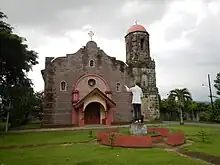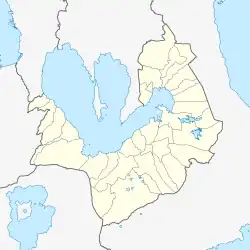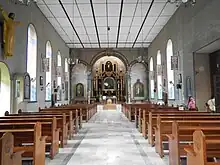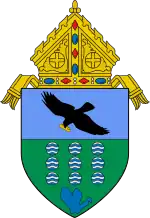| Mabitac Church | |
|---|---|
| Nuestra Señora de Candelaria Parish Church | |
 Church above the hill | |
 Mabitac Church .svg.png.webp) Mabitac Church .svg.png.webp) Mabitac Church | |
| 14°25′31″N 121°25′34″E / 14.42529°N 121.42623°E | |
| Location | Mabitac, Laguna |
| Country | Philippines |
| Denomination | Roman Catholic |
| History | |
| Status | Parish |
| Architecture | |
| Functional status | Active |
| Architectural type | Church building |
| Specifications | |
| Materials | Adobe stones |
| Administration | |
| Archdiocese | Manila |
| Diocese | San Pablo |
| Clergy | |
| Priest(s) | Ernani Carillo |
The Nuestra Señora de Candelaria Parish Church informally known as Mabitac Church is a Roman Catholic church located above Calvary or Kalbaryo Hill in Mabitac, Laguna, Philippines. Its church is known for having a staircase of 126 steps, a panoramic view of the town of Sta. Maria and Laguna lake,[1] and the festivity of the Three Kings every January 6, a re-enactment of the Magi's journey.[2]
Church history
Mabitac was under the patronage of Nuestra Señora de Candelaria or the Our Lady of Candles. The image of Nuestra Señora de Candelaria was commissioned between 1599 and 1600 by the alferez, Don Cristobal Mercado for Paco Church.[3] After three years, in 1603, it was first brought to a hospital-chapel in Los Banos.[3] It was transferred to Siniloan in 1615 upon the request of Father Juan Miguel de Talavera to his superior, Father Blas de la Madre de Dios.[4] His plan was to place it on a little mount between Inaguasan and Galoy, two barrios of Siniloan, in aid of unification around his place.[1][5] The people of Mabitac sought the image to be placed in Mabitac and was enthroned to their town in that same year.[6]
The first church of Mabitac was the aforementioned church between the two barrios of Siniloan.[5] Due to flooding, the Franciscans transferred the church on top of Calvary or Kalbaryo Hill in 1618 and made it out of stone.[7][8] Originally, the church only had 96 steps[7] but further improvements increased it to more than 120 steps.[9] It was seriously damaged during the 1880 earthquake and repaired under the supervision of Father Antonio de la Fuente and again severely damaged during the 1937 earthquake.[6]
Features

The church is known for its 126 steps connecting the local road to the main church on top of the hill.[9][10] It has a Spanish style façade.[9][10] Due to natural calamities and war, only the belfry connected to the church is the remaining original structure of the original 1618 church. Since it became serviceable after the 1937 earthquake, the church was greatly improved into its interior.[6]
Notes
- 1 2 "Laguna's old churches await pilgrims". Philippine Daily Inquirer. March 24, 2005.
- ↑ Cinco, Maricar (January 12, 2011). "Mabitac folk hope fest way to progress". Philippine Daily Inquirer. Archived from the original on October 7, 2014. Retrieved August 21, 2014.
- 1 2 Huerta 1865, p. 146
- ↑ Huerta 1865, pp. 146–147
- 1 2 Huerta 1865, p. 147
- 1 2 3 National Historical Institute 1993, p. 68
- 1 2 Huerta 1865, p. 148
- ↑ Giron, Tita (March 20, 2005). "A scenic way to do the traditional 'Via Crucis'". Philippine Daily Inquirer.
- 1 2 3 "Churches south of Manila you can visit on Holy Week". Manila Bulletin. March 2, 2014. Retrieved August 21, 2014.
- 1 2 "Laguna: Prime Attractions". Provincial Government of Laguna. Archived from the original on August 26, 2014. Retrieved August 21, 2014.
Bibliography
- Huerta, Felix de (1865). Estado geográfico, topográfico, estadístico, histórico-religioso. Binondo: Imprenta de M. Sanchez y Ca. pp. 146–149.
- Historical Markers: Regions I-IV and CAR. Manila: National Historical Institute (Philippines). 1993. p. 68. ISBN 9715380611.
External links
 Media related to Nuestra Señora de Candelaria Parish Church of Mabitac at Wikimedia Commons
Media related to Nuestra Señora de Candelaria Parish Church of Mabitac at Wikimedia Commons
